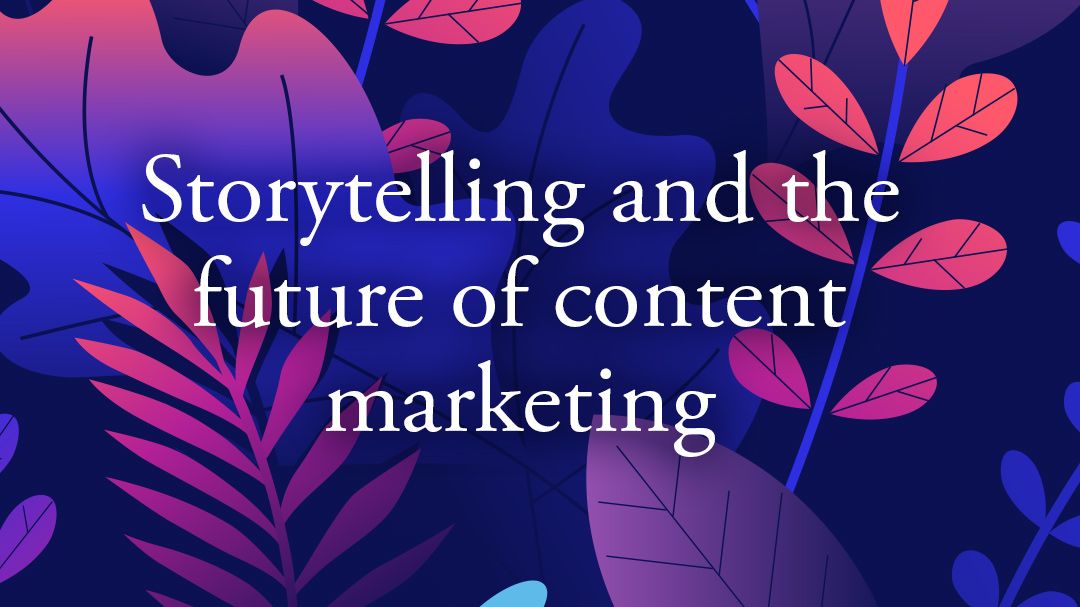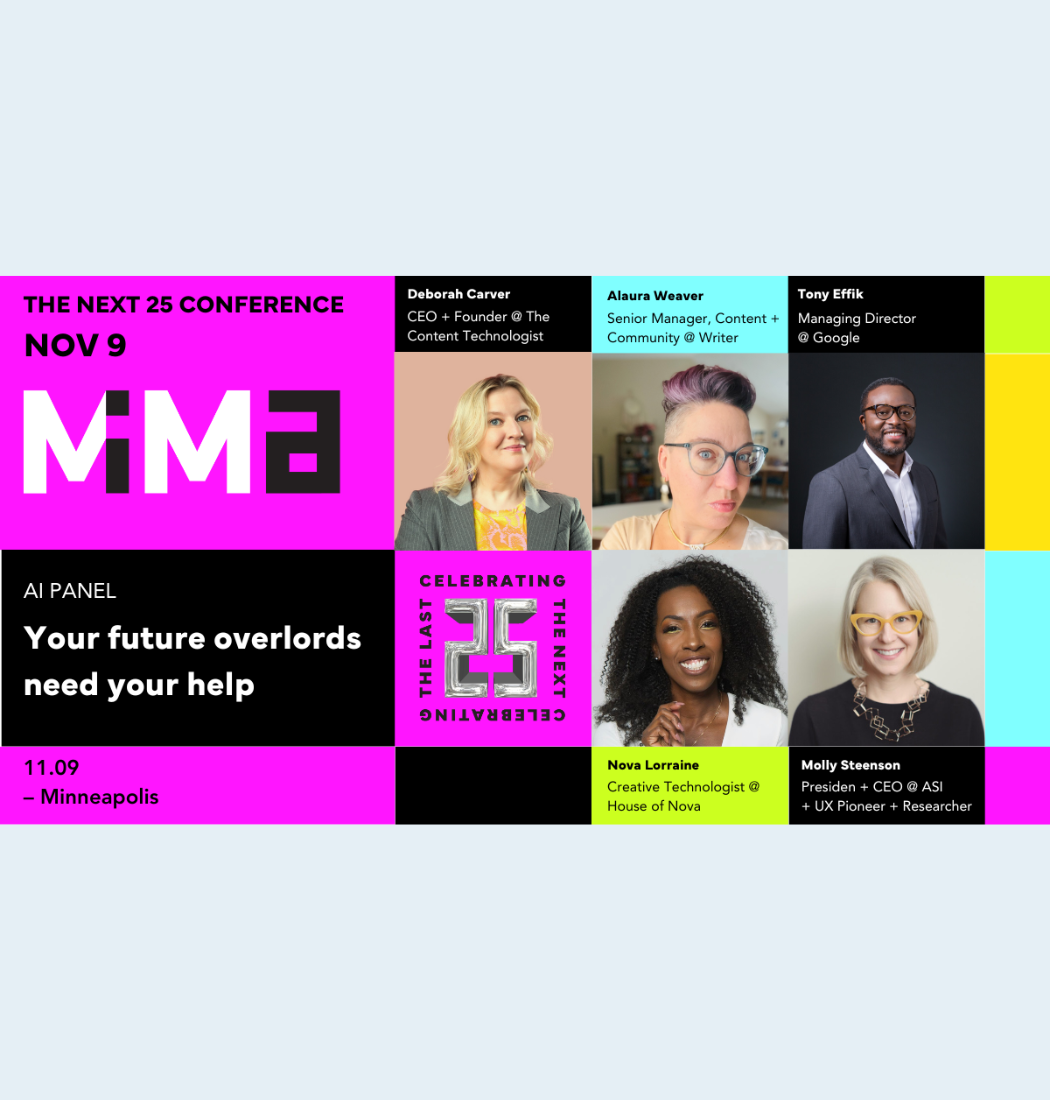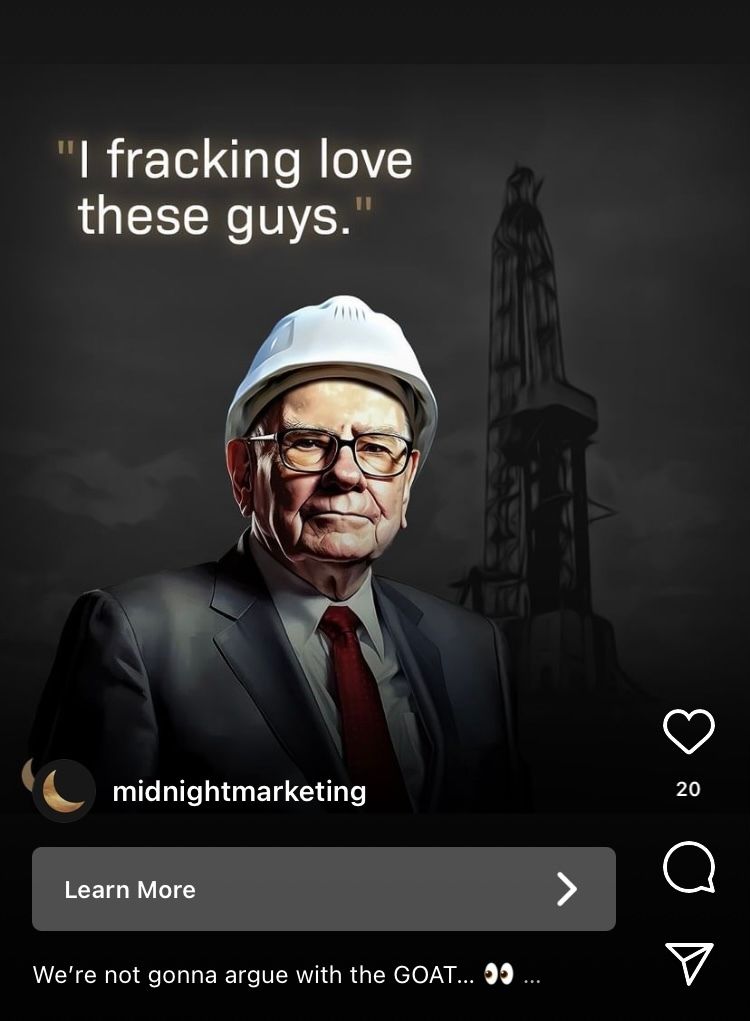In this issue:
- Housekeeping
- Blast from the past but still a red herring: The tyranny of landing pages
- In links: Social discovery is broken, but we may be "excited" for whatever comes next
- Did you read? Jann Wenner and the crying couch
A bit of news: Further down in the issue, you'll find a promotion for the Minnesota Interactive Marketing Association (MIMA) event that I'm hosting on November 9. If you're in the Twin Cities, I highly recommend that you stop by. These folks are the best of the best in regards to AI, and I'm stoked to tease out ethics.
Unfortunately, we're cancelling our November 3 Practical AI event, as I am but one person and don't have brain capacity to prep for both events. If you've already bought a ticket, your admission will be refunded AND you'll get a free admission to the December 1 salon, where we'll be sharing some really cool original research.
++
Today’s essay is a rerun, yes, but it’s still massively relevant two and a half years later – especially with the legions of growth hackers drooling at the opportunity to automate their landing page strategies with AI. Although the “landing page jail” tactic described in this article has lost popularity in the past couple of years (huzzah!), many content strategies still place far too much emphasis on individual landing page experiences, rather than building a collection of content over time.
But! We think some landing pages are fantastic. In fact, we are launching some of our own today, quietly, on content-technologist.com, just before this email will be mailed. They’re offer landing pages, meaning that they go in-depth into a specific product while still remaining connected within the whole website—little all-inclusive resorts rather than deserted islands.
And out in the rest of the world, here are three winning landing pages that do their job and still look fabulous:
- Shorthand, an immersive content platform we’ve reviewed before, created a landing page that reflects their offering and shows off the best of their capabilities. It reflects advice you may have heard in your college writing workshops: Show, don’t tell.
- Webflow, another favorite of ours, designed a full-page platform overview with a focus on their content management system, in a landing page that serves both organic visitors and paid media campaigns.
- And The Publish Press, a newsletter by YouTubers Colin & Samir, gets the most out of their “landing page jail” experience, by describing the product… in the screenshot of the product. It’s a clever way to get more text on a page that can convert audiences from other social media platforms into subscribers.



–DC
Sponsors and promotions

What are the ethics of using generative AI for content creation?
At the annual MIMA summit, we'll explore the moral and legal minefields of generative AI. Who is responsible for AI ethics, and how do we keep humans in the loop?Join us on November 9 in Minneapolis. Use code "SEEMEINMN" for 20% off your conference ticket.
Get your ticket todayUpcoming events
Rerun: The tyranny of the landing page
by Deborah Carver
This essay originally was published on April 22, 2021, with the email subject line CT No. 78: "Landing page islands and design-forward websites," alongside a review of visual website builder Webflow.
Freelance content strategy gigs cover a multitude of tasks, a good percentage more accurately described as "writing sales automation collateral" than anything remotely related to strategy. Too many "content strategy" or "digital strategy" job descriptions read:
"Create landing pages and drip campaigns* for marketing initiatives"
From Fortune 500s to side gig start-ups, business folks who have listened to one podcast on digital growth marketing or the creator economy think, "All we need is a best-in-class landing page and some emails and we'll get thousands of subscribers/leads/clients."
Landing pages are the calling card of the growth hacker, positioned as "all you need" to grow your digital business. "Drive traffic to the landing page" is the most time-worn of hastily considered digital marketing tactics: pay for the ad placement on your search engine or social network of choice, then watch the form fills roll in.
Great landing pages absolutely exist, and success stories like Morning Brew prove that a landing page customer acquisition strategy can work if you have a promising product, a robust referral network, and a chunk of venture capital to spend on PPC and paid social.
*"Drip campaign" remains the grossest phrase in marketing... 2.5 years after this article was originally written.
What is a landing page and how is it best used?
I'm discussing single-use landing pages created through software (i.e., LeadPages, ConvertKit, Unbounce, Instapage, there are a million of 'em) that stand alone from your existing website. I'm not talking about "category" or "pillar" landing pages built into a website, often a collection of related content carefully optimized to attract traffic on certain topics.
Landing pages are fantastic for certain types of products, including:
- Events of all shapes and sizes
- Giveaways
- Rewards/referrals
- Single-use PDFs, exclusive videos or other gated content "moments"
- Awards submissions
- Single-use quizzes or calculators
- Courses, email or otherwise
You probably get the idea: Landing pages are excellent for temporal content designed to convert a limited audience in a short period of time. They work best when coupled with ad targeting, that increasingly fraught and occasionally effective tactic rooted in either ad placement or users' browsing behavior.
Why don't landing pages have a place in a long-term content strategy?
When I see software that advertises "unlimited landing pages," I get a little sick to my stomach. That phrase is almost always paired with "segmentation" and "testing," two poorly understood tactics that beget disappointing results from all but the most experienced digital marketers.** I flash back to potential clients in my early days of freelancing, asking me to create lots and lots of landing pages, one for every segmented audience for every campaign.
I didn't work with those clients because I know they'll blame the content and the freelancer when the landing pages fail. In the pitch process, they certainly didn't want to hear my content strategist advice: it's probably best to make a full website if you want to develop more than 5 landing pages.
To put it in our favorite VC terms: landing pages do not scale long-term, especially if you are considering both content and brand strategy. Landing pages are the digital equivalent of a punk show flier, a customer interaction akin to Buddy the Elf accepting leaflet after leaflet in front of a Times Square store.**
For most publishing or content marketing initiatives, even newsletters, a landing page-based acquisition strategy is a recipe for burning money over time.
Companies like landing pages because you can whip up a quick one-pager, use a template to create a form, and no one has to think about information architecture, SEO or fitting into the grand website or content strategy. The landing page is a little island for the initiative.

Little islands quickly become archipelagos, and suddenly you're creating a landing page for every persona or pain point because your marketing automation software says you can. In the span of a few short landing pages, you've created a bevy of words and ideas that display your nuanced, multifaceted content strategy that... only exists on a few disconnected landing pages that will be forgotten soon after the campaign ends.
**If you are A/B testing button color... well, unless you've been doing this for a while, you're wasting resources. Spend more time getting to know your customers. If you are really concerned about button color, just make it red.
***The Midtown montage in Elf is one of the best NYC moments of cinema ever filmed. Did those overpriced midtown electronics stores survive the pandemic?
Landing page jail does not build trust
Landing pages work best if you create "landing page jail," aka the worst UX on the planet. Sometimes called a "squeeze page," a landing page jail is content with a form, with no external links or navigation—all the features that make websites useful. Users have no options to click away to another part of your navigation in landing page jail; the only choices are to fill out the form or close the tab. Landing page jail is most often hosted on a company's web domain but not integrated with the resource-filled website.
Landing page jails assume that your customers don't know how to use a website or, frankly, have any autonomy to follow information scent or seek out trust signals on their own. Like too many digital marketing tactics, they seek to capture a single moment of fleeting interest rather than woo an audience member with a deeper connection. They're a bit like meeting a romantic prospect on a big night out—full of promise, but realistically unlikely to lead to a commitment.
You're almost always paying for landing page traffic
Landing pages rarely rank in organic search results. They never rank on non-branded terms. The strategy for creating and optimizing them is distinctly different from organic search optimization.
To get traffic to your landing page, you either have to pay for it or constantly promote it, both of which are resource intensive. The latter is annoying for both content producers and users, and takes away from other high-quality content. Landing pages are outbound-ish. Cost of customer acquisition (CAC or CAQ if you're into acronyms) with a landing page is exponentially higher than that acquired through organic search.
Businesses get wooed quickly by fast results from a landing page-based campaign, but those results are directly tied to ad spend and novelty. At some point, both of those wear out their welcome. You can only yell in a customer's face so many times about a new product.
If you're choosing a landing page-based strategy, be realistic about results: If you start with a mailing list—let's be extremely generous at 30k opt-in subscribers, 50% of whom open, 15% of whom click—you'll be lucky if your campaign has a total 2% conversion rate, no matter how many landing pages match your audience segments. That's 45 total form fills. Those rates drop significantly if your mailing list is not opt-in or if you're using paid search or social for promotion. Every time you "drip" an email, those rates drop. Eventually you're squeezing blood from a stone.
Landing pages don't attract committed audiences
Events pros will understand this one: if your cost of admission and value proposition is too low, you'll attract your audience, but you'll also attract randoms that don't care about the community or have no personal interest in your content.
Landing pages are designed to be low-commitment and temporary. Impermanence invites churn. Your audience has no incentive to stay—all they saw was a landing page that they'll never find again, so if they don't like the most recent issue, had a rotten day that coincided with your event, or dislike the frequency with which you promote your content (because you're only using landing pages), you risk losing them as brand customers forever. Once they're on your suppression list, you can never email them again.
Your website is more than a collection of landing pages
Organic traffic, in tandem with a solid paid media/landing page strategy, builds a more permanent brand footprint and a higher quality audience. Appearing in search for both branded and non-branded keywords—as well as for your regular slate of events and content—mean that your audience can find your content when they want it, and not just when it's pushed to them.
New digital business owners and publishers alike misunderstand exactly how much high-quality traffic organic search attracts. Some publishers and thought leaders lump organic search in with all "algorithms" and social organic discovery and abandon the concept entirely, which is just... super duper off-base and missing out on so much growth potential! Even for half-optimized websites, organic search attracts upwards of 30% of total website traffic and the highest quality leads. For most optimized publishers and digital businesses, organic search attracts at least 50% of new readers over time, without constant promotion.
A website, no matter how "hard" it is to build, is the best home and most effective investment for sustainably growing a content-based business over time. Landing pages are great quick fixes and one-offs, but if you're creating them in bulk, know that you can make that landing page content work so much harder for your brand.
Deborah Carver is the publisher of The Content Technologist.
From the bottom of the chum bucket
Our weekly chum bucket explores all the weird programmatic ads we find on social networks. Because "targeted advertising" is a weird, weird thing.

Sponsors and promotions
Agencies: How sophisticated is your content strategy offering?
Content strategy has changed wildly in the past ten to fifteen years. How does what you're offering clients compare with what actually works? Take The Content Technologist's assessment for digital development, creative, and marketing agencies.
Take the agency assessmentContent tech links of the week
- An absolute delight: Betches.com's Corporate Jargon Glossary, which was painfully accurate to read as a middle aged person who says many of these jargony terms. Especially "excited." Because I'm old and boring and my work generally excites me, even though, in the scheme of things, it's extremely nerdy and boring.
And also "voluntold" because it's a longtime favorite and I hadn't thought about its particular delight in a couple of years. - In Nothing on the internet is forever, Chris Dalla Riva talks not only about how "those party pictures you post on Facebook will ruin your life!" was bunk, but also about one of my least favorite recent trends: the slight shift of the canonical (album covers, contentious lyrics, etc.) on streaming music services.
- Our friends at Storythings have put together a great argument about how social media discovery—at least through organic content—is broken for many companies who relied on third party platforms to build audiences.
- Rockstar critic Lindsay Zoladz is the New York Times' first mixtaper. Nieman Lab has a solid explainer of what the role entails. As someone with a (secret, friends-only) playlist newsletter, I'm glad the mixtape email newsletter (such an old format! I received many mixtape newsletters in the Napster era) is reaching the mainstream.
The Content Technologist a company based in Minneapolis, Los Angeles, and around the world. We publish weekly and monthly newsletters.
- Publisher: Deborah Carver
- Managing editor: Wyatt Coday
- Production assistant: M.E. Gray
Collaborate | Manage your subscription
Affiliate referrals: Ghost publishing system | Bonsai contract/invoicing | The Sample newsletter exchange referral | Writer AI Writing Assistant
Did you read? is the assorted content at the very bottom of the email. Cultural recommendations, off-kilter thoughts, and quotes from foundational works of media theory we first read in college—all fair game for this section.
As a middle-aged, midcareer person who manages other people (a "boss" in the common parlance), I roll my eyes a bit at the recent spate of "bad workplace" stories, which focus on individual anecdotes of crying at work, which, to be honest, is not a rare thing, nor is it indicative of anything but perceived high stakes, big egos, and potentially some depression/anxiety/substance abuse issues that tend to collide when you mix creatives and industry.
I'm of the elder millennial "a million other girls just like you want your job" generation, and although I'm pro-labor, a grandchild of the proletariat, I'm also aware of how the dynamics of creative workplaces do not always meet the expectations we have early in our careers. I have cried, and I have made people cry (unintentionally, and I apologize after the fact). When we care about our work, we are often disappointed. Welcome to the work world, baby girl: it's gonna break your heart.
So when I began reading this Substack about how women were treated at Rolling Stone, I began with minimal sympathy. I'm an avid feminist, but yikes, Rolling Stone is an independent publication with a long history of being incredibly not-feminist—and yet, it was still beloved by me and many others. I read every issue cover to cover when I was a teen (well, except for the international politics articles because boring!) and adored its counter-culture sensibility and pictures of sexy rockstars. It was like the anti-Seventeen as far as I was concerned.
I haven't read in years because now it just seems behind the times, and their website has always been a garbage fire. But I remember how revolutionary it felt, growing up suburban and Catholic, seeing the occasional female rock star in the magazine when women's voices in the radio and across culture were scarce.
But Jann Wenner's misogyny is not news. I came of age during the Girls Gone Wild era, and the magazine leaned hard into its laddiness. It's disappointing, especially his recent comments, but not unexpected.
Look, work sucks (I know), but I will say, from experience: you will be wayyyyy more disappointed and jaded after the fact when a woman CEO makes you cry, multiple times, and then the next woman CEO makes you cry, too. Yes, I am sure these dudes said horrible things, but that's not specific to a sexist workplace.
Had they read Rolling Stone before accepting a job there? From late-night proofreads to writer temper tantrums, it all tracks to the magazine's history and culture. Jann Wenner discovered and championed Hunter S. Thompson, P.J. O'Rourke, Matt Taibbi... FFS. He's not gonna be your nice granddad who lets everyone take a turn at driving the boat. He's an independent publisher of a rock n roll magazine who still feels oppressed by the man, man, even when he's the man.
And they had an old leather couch to cry on? I felt a bit like Duckie in the girls' room discovering a "candy machine" when I read that intro. In my day, I always had to hide myself in the bathroom stall, perching on the toilet if I wanted to sit with my frustration. A million other girls wanted my job!
But then I got to this quote, from a former special projects editor Nina Pearlman: "There would be these men—young men—who would start as interns who would be so respectful to me, and then they would get higher up and then they would be dismissive of me, and I'm the same person. What happened to you?" And that was when I paid attention.
Because it's not just an old man who is behind the times. It's the younger men who still emulate Wenner's example, who see his success as infallible and as a result of the misogyny, not despite it. And that part is heartbreaking.
Crying at work is part of the system, but changing attitudes toward your coworkers because you'll feel more accepted by senior management, or because you begin to equate sexism and misogyny with success – that's the issue.
I think we've established that Jann Wenner is no longer cool (his most recent book only sold 800 copies in its first week? yikes). But I'm hoping that we shift toward a model of mutual respect at work, where it doesn't matter which team you work on or what your background is. Some people suck, yes, but when we're at the same company, we're technically all on the same team, and your coworkers are always deserving of respect and kindness.
–DC



